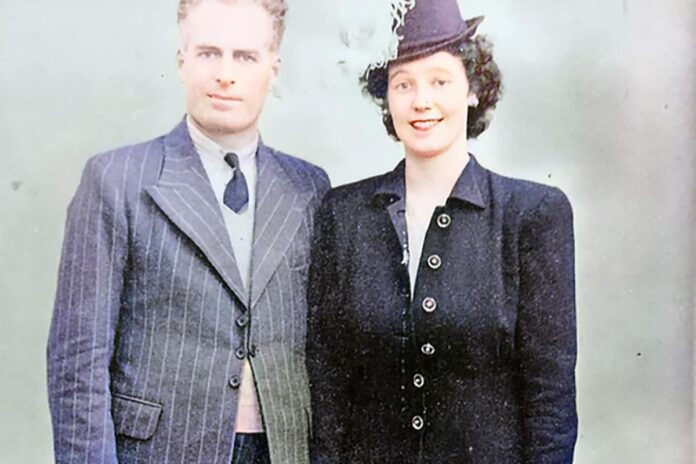The data collected that morning was the most significant yet. About 7,000 ships and landing craft, 11,000 aircraft and more than 130,000 Allied troops were amassed for Operation Overlord, the invasion into Nazi-occupied France. The only missing puzzle piece was the weather forecast for the English Channel to decide if June 5 would be D-Day.
The storm observations from County Mayo were the first indications of trouble ahead. The invasion was postponed until June 6. And the postal worker — 21-year-old Maureen Flavin — became part of World War II lore as a linchpin in the weather team whose work persuaded commanders to hold off for 24 hours the air-and-sea assault that helped change the course the war.
“They could arrange everything, but they couldn’t prearrange the weather. … We eventually had the final say,” Maureen Flavin Sweeney, who died Dec. 17 at 100, later recalled.
Ms. Sweeney was one of the many civilian women involved in nearly every facet of the war effort from the factory floor (think Rosie the Riveter) to assisting in military command centers to leading community mobilizations such as organizing scrap drives. Few, however, had moments so directly connected to major decisions as Ms. Sweeney on that gloomy June morning.
For a tense few hours, her weather readings and observations were given top priority as they moved up the chain of command to Group Capt. James Martin Stagg, a Met Office meteorologist attached to the Royal Air Force. Stagg also was the chief weather adviser for Gen. Dwight D Eisenhower, who was in charge of D-Day operations.
In the era before satellite imagery, the weather forecast was pieced together based on barometric data, wind patterns, cloud formations, and sometimes just accumulated local knowledge of the skies and seas.
Early June was picked for D-Day because of lower-than-normal tides and a moon cycle that provided darkness during the early stages of the invasion and, on a clear night, a moon glow after rising later on. Missing the window was a scenario “too bitter to contemplate,” Eisenhower said.
“A bad forecast would jeopardize the entire operation,” wrote author John Ross in “The Forecast for D-Day” (2014). “If [Eisenhower] gave the word to ‘go,’ and the weather turned sour, the lives of thousands of men and massive amounts of equipment would be lost.”
As Stagg reviewed the incoming information — from Ms. Sweeney and other weather watchers — nothing looked promising. At 11 a.m. in County Mayo, the phone rang at the Blacksod post office. “A lady with a distinct English accent requested me to ‘Please check. Please repeat,’” Ms. Sweeny recounted in an interview with Ireland’s RTÉ.
“We began to look at the figures again. We checked and rechecked,” Ms. Sweeney said. (Although Ireland declared itself neutral, the country’s head of government, Éamon de Valera, agreed to share weather intelligence with the Allies.)
Stagg’s weather map was coming together, with added reports from seagoing vessels.
By the end of the day, it showed two major low-pressure areas — one south of Greenland and the other just north of Scotland. They created a cyclone effect that passed though the Channel from June 4 into June 5, with winds of up to 30 mph and sheets of rain. The conditions effectively nixed the core of the D-Day operations: the massive amphibious landing on Normandy beaches and airdrops of paratroopers behind the German lines.
“The invasion would have been a complete disaster,” Ms. Sweeney told RTÉ. “There they were with thousands of aircraft and they couldn’t tolerate low cloud.”
The weather cleared sufficiently by June 6, 1944, for the invasion to begin. “You are about to embark upon the Great Crusade, toward which we have striven these many months,” Eisenhower wrote in his message to the Allied Expeditionary Force. “The eyes of the world are upon you.”
For more than a decade, Ms. Sweeney was unaware of her part in D-Day. As once-secret war information was unsealed, the connections were made between the D-Day postponement and the weather data, including the early reports from Blacksod.
In 2021, in a ceremony at her nursing facility in Belmullet, Ireland, Ms. Sweeny’s role in the war was cited by the U.S. House of Representatives. A friend, Ruth O’Hagan, wrote a poem for Ms. Sweeney, “The Girl Who Changed the World.” It begins:
Please check. Please repeat.
The howling winds of Blacksod spoke.
Please check. Please repeat.
Maureen Flavin was born in Knockanure in County Kerry on June 3, 1923. After secondary school, she became a clerk at the post office in Blacksod, a village where her uncle ran a pub. The post office also served as a weather station, sending reports to Dublin that, during World War II, were shared with British officials and Allies forces.
After the war, she married Ted Sweeney, a lighthouse keeper, who had helped check her weather readings in the prelude to D-Day. Ms. Sweeney eventually took over operations at the post office, keeping the position for more than six decades.
The couple conducted weather readings until an automatic metrological station was installed in 1956.
Ms. Sweeney’s husband died in 2001. Survivors include a son, Vincent Sweeney, and a grandson, Fergus Sweeney, who confirmed the death. No cause was given.
Shortly before his inauguration, President-elect John F. Kennedy reportedly asked President Eisenhower for details on why D-Day succeeded.
“Because,” Eisenhower said, “we had better meteorologists than the Germans.”



